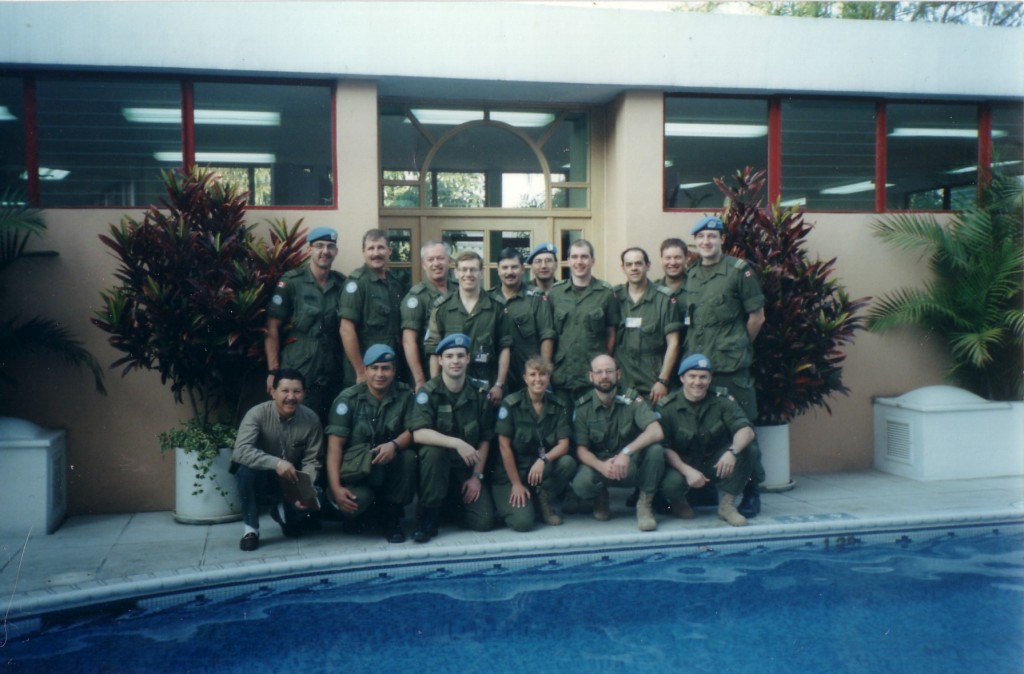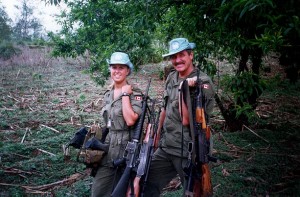
15th Anniversary of MINUGUA
Canada’s contribution to the United Nations Mission in Guatemala (MINUGUA) was perhaps small in size but it was certainly not insignificant. After a brutal 36-year civil war between the Guatemalan government and the leftist wing guerrilla movement known as the URNG (National Revolutionary Unit of Guatemala), an armistice was signed in December 1996 known as the Agreement on a Firm and Lasting Peace. The United Nations established a mission to verify the ceasefire and conduct human rights verification, effectively ending the longest war in Latin America which had seen over 150,000 killed, one million displaced, 45,000 missing persons, and the destruction of over 400 villages.
Then-Foreign Affairs Minister Lloyd Axworthy committed to sending a contingent of fifteen Spanish-speaking Canadian officers to act as military observers. Selected from across the Army, Navy and Air Force, the Canadian UNMOs subsequently joined an additional 131 from 14 other countries, to deploy to one of six verification centres or two headquarters across the country. Once in Guatemala – a country about the size of New Brunswick but with 17 times its population – the Canadian UNMOs (and their in-theatre assignments) included: Alexander Fieglar (HQ), Louis Lafrance (HQ), Walter Watkins (Quiche), Robert Champagne (Claudia), Bob Taylor (Claudia), Doug Eaton (Las Abejas), Alex Dieryckx (Las Abejas), Pierre Vandoesburg (Mayalan), Carlos “Chico” Belsham (Mayalan), Miguel Gonzalez (Sacol), Claude Vadeboncoeur (Sacol), Luis Araujo (Tululche), Carlos Olivas (Tululche), Paul Lansey (Tzalbal) and Eva Martinez (Tzalbal) – Canada’s first female military observer and the first female military observer in the world to serve in Central America.
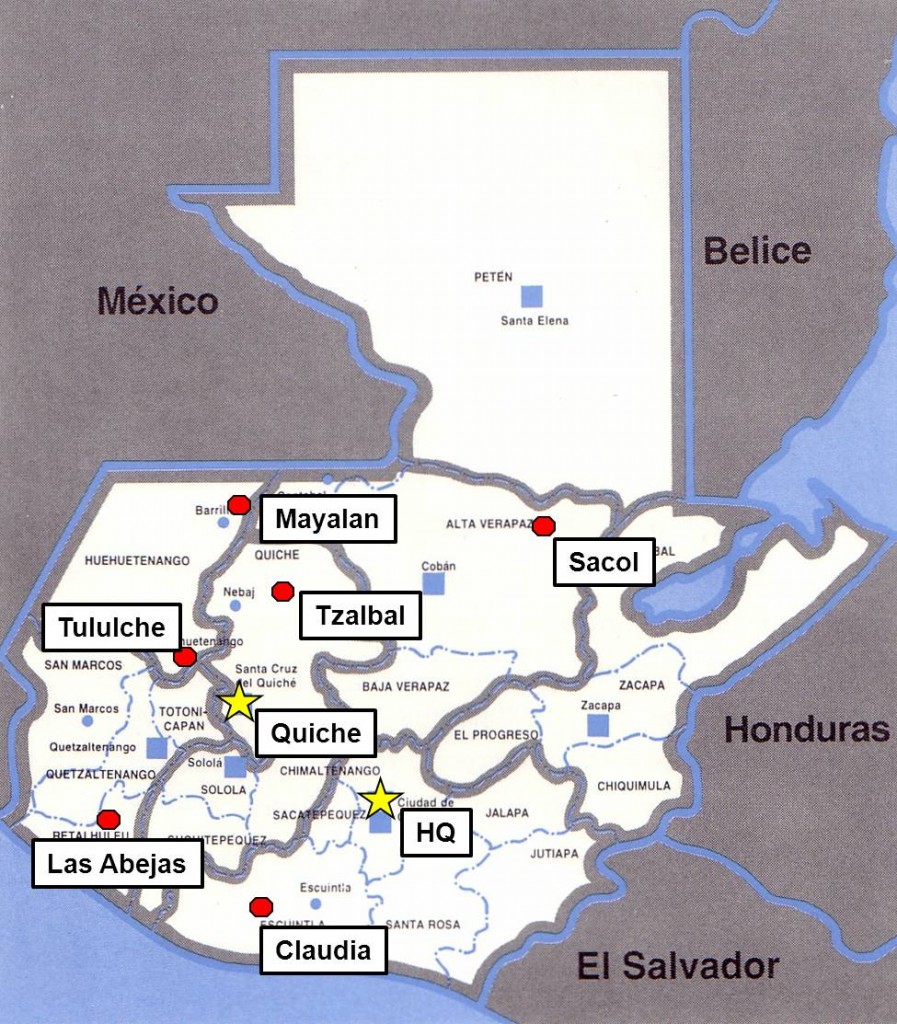 The first phase of the mission was the verification of the agreed-upon ceasefire. The second phase was to maintain separation between the Army and the URNG in clearly defined security zones.
The first phase of the mission was the verification of the agreed-upon ceasefire. The second phase was to maintain separation between the Army and the URNG in clearly defined security zones.
In phase three, the UNMOs dismantled the URNG organization. This was carried out by escorting over 3000 URNG guerrillas from their camps to the UN verification centres where they were disarmed and given civilian clothing in exchange for their uniforms.
The fourth phase of the mission was to oversee the integration of ex-combatants into civilian life. An additional component of the mission was the demining of the Tajamulco Volcano where UNMOs retrieved 378 land mines and explosive devices. At the end of the mission, over half a million weapons and over three million rounds of ammunition were turned over to Interior Ministry officials.
As 2012 marks the 15th anniversary of this peacekeeping mission, it seems an opportune time to raise awareness about this little-known slice of Canadian blue beret history. or more information, please contact Major (ret) Eva Martinez (Class of 93 – 18866) at bronte@sympatico.ca
15ème Anniversaire de MINUGUA
La contribution du Canada aux Nations Unies pour la mission au Guatemala (MINUGUA) était peut-être d’une taille petite mais elle n’était certainement pas insignifiante. Après une guerre civile brutale de 36 ans entre le gouvernement guatémaltèque et le mouvement d’aile gauche de guérillero connus sous le nom d’URNG (Unité Révolutionnaire Nationale du Guatemala), un armistice a été signé en décembre 1996 connu comme «Agreement on a Firm and Lasting Peace». Les Nations Unies ont établi une mission pour vérifier le cessez-le-feu et pour conduire la vérification de droits humaines, finissant effectivement la plus longue guerre en Amérique latine laquelle avait vu plus de 150.000 tués, un million de personnes déplacées, 45.000 disparus, et la destruction de plus de 400 villages.
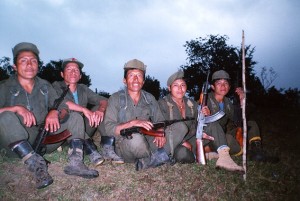 Le Ministre d’Affaires Étrangères a ce temps, Lloyd Axworthy, avait commis à envoyer un contingent de quinze officiers canadiens qui parlaient l’espagnole pour agir en tant qu’observateurs militaires. Choisi de l’armée, de la marine et de la force aérien, les UNMOs Canadiens ont joint des 131 supplémentaires de 14 autres pays, et déployés à un de six centres de vérification ou deux sièges sociaux à travers le pays. Une fois au Guatemala – un pays la taille du Nouveau Brunswick mais avec 17 fois sa population – les UNMOs Canadiens (et leurs destinations de théâtre) ont inclus: Alexander Fieglar (HQ), Louis Lafrance (HQ), Walter Watkins (Quiche), Robert Champagne (Claudia), Bob Taylor (Claudia), Doug Eaton (Las Abejas), Alex Dieryckx (Las Abejas), Pierre Vandoesburg (Mayalan), Carlos “Chico” Belsham (Mayalan), Miguel Gonzalez (Sacol), Claude Vadeboncoeur (Sacol), Luis Araujo (Tululche), Carlos Olivas (Tululche), Paul Lansey (Tzalbal) et Eva Martinez (Tzalbal) – la première observatrice militaire féminin du Canada et la première observatrice militaire féminin du monde à servir en Amérique Centrale.
Le Ministre d’Affaires Étrangères a ce temps, Lloyd Axworthy, avait commis à envoyer un contingent de quinze officiers canadiens qui parlaient l’espagnole pour agir en tant qu’observateurs militaires. Choisi de l’armée, de la marine et de la force aérien, les UNMOs Canadiens ont joint des 131 supplémentaires de 14 autres pays, et déployés à un de six centres de vérification ou deux sièges sociaux à travers le pays. Une fois au Guatemala – un pays la taille du Nouveau Brunswick mais avec 17 fois sa population – les UNMOs Canadiens (et leurs destinations de théâtre) ont inclus: Alexander Fieglar (HQ), Louis Lafrance (HQ), Walter Watkins (Quiche), Robert Champagne (Claudia), Bob Taylor (Claudia), Doug Eaton (Las Abejas), Alex Dieryckx (Las Abejas), Pierre Vandoesburg (Mayalan), Carlos “Chico” Belsham (Mayalan), Miguel Gonzalez (Sacol), Claude Vadeboncoeur (Sacol), Luis Araujo (Tululche), Carlos Olivas (Tululche), Paul Lansey (Tzalbal) et Eva Martinez (Tzalbal) – la première observatrice militaire féminin du Canada et la première observatrice militaire féminin du monde à servir en Amérique Centrale.
La première phase de la mission était la vérification du cessez-le-feu. La deuxième phase était de maintenir la séparation entre l’armée et l’URNG dans des zones de sécurité bien définies.
Dans la phase trois, les UNMOs ont démantelé l’organisation d’URNG. Ceci a été effectué par l’escorte de plus de 3000 guérilleros d’URNG de leurs camps jusqu’aux centres de vérification de l’ONU où ils ont été désarmés et donnés des vêtements civils en échange de leurs uniformes.
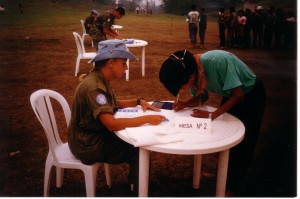 La quatrième phase de la mission était de surveiller l’intégration des ex-combattants dans la vie civile.
La quatrième phase de la mission était de surveiller l’intégration des ex-combattants dans la vie civile.
Un composant supplémentaire de la mission était le déminage du volcan de Tajamulco où des UNMOs ont recherché 378 mines terrestres et dispositifs explosifs. À la fin de la mission, plus d’un demi-million d’armes et plus de trois millions de séries de munitions ont été retournés aux fonctionnaires de ministère de l’Intérieur.
En tant que 2012 dénote le 15ème anniversaire de cette mission de maintien de la paix, c’est un moment opportun de partager cette tranche peu connue d’histoire des bérets bleues canadiennes. Pour plus d’information, contactez svp le Commandant (retirée) Eva Martinez (Classe de 93 – 18866) a bronte@sympatico.ca


